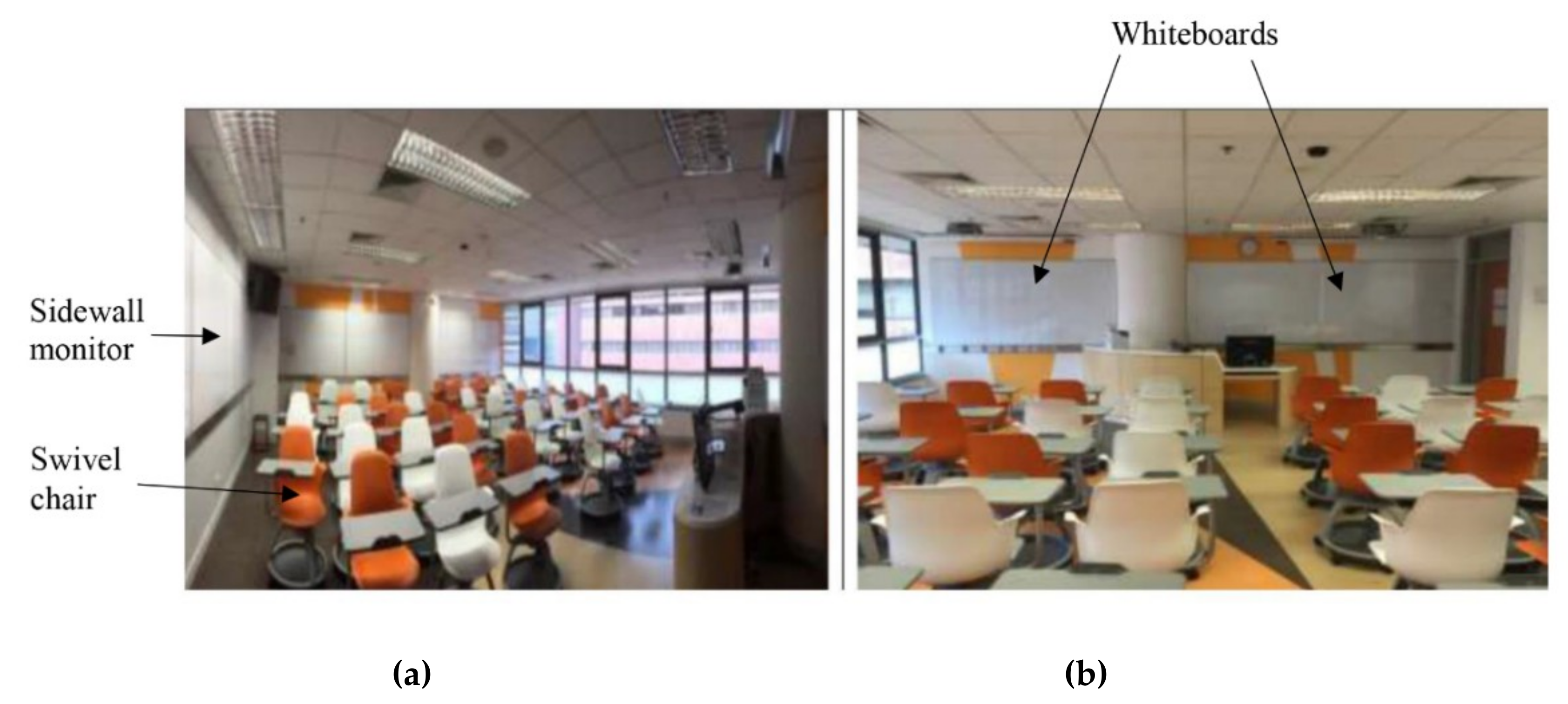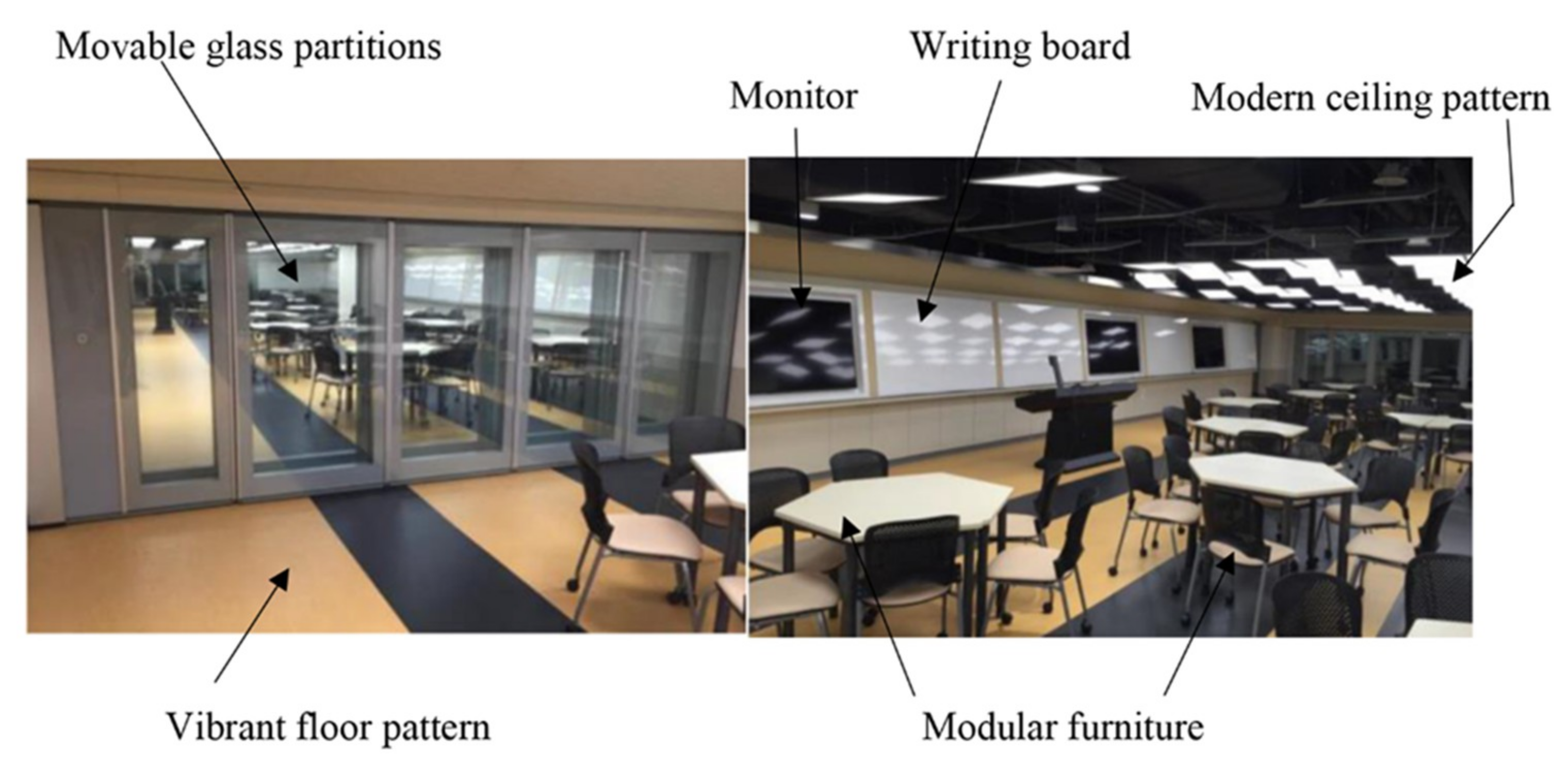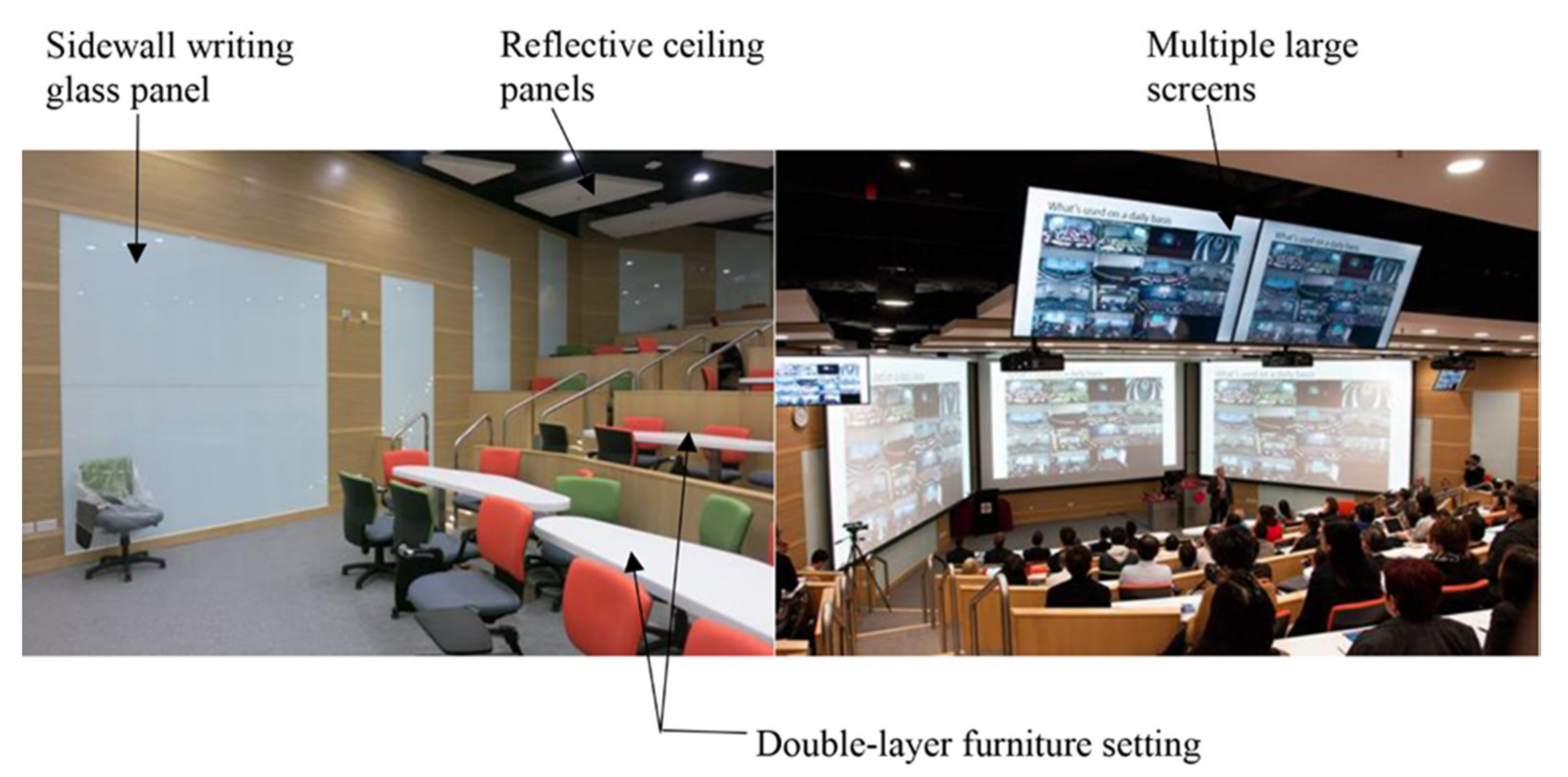The Architecture of Built Pedagogy for Active Learning—A Case Study of a University Campus in Hong Kong
Abstract
1. Introduction
2. Current Pedagogical Changes
3. Design Principles of Active Learning Spaces
4. Overview of Learning Space Renovations in The Hong Kong Polytechnic University Campus
4.1. Upgrading of Classroom (QR-611)
4.2. Refitting of Classroom (BC-404)
4.3. Reconfiguration of Classrooms (N-001, N-002, and N-003)
4.4. Refitting of Lecture Theater (TU-201)
5. Empirical Questionnaire Survey for End-User Students
5.1. Development of Survey Instrument
5.2. Data Analysis of Survey Responses
6. Findings and Discussions
7. Summary and Conclusions
- Reduce cooling/heating loads by providing insulation to walls.
- Eliminate glare by installing adjustable blinds.
- Use natural lighting as far as possible, such as high windows, that will not distract student attention to external environment.
- Facilitate natural ventilation by ventilation shaft.
Author Contributions
Funding
Acknowledgments
Conflicts of Interest
Appendix A—Template of Survey Form
Project Title: Impact of Learning Space on Teaching and Learning Effectiveness (Student Survey at PolyU)
Part A—Opinions on Learning Space Design
| Items | 1 | 2 | 3 | 4 | 5 | |
| 1 | Modern Technologies | |||||
| 1.1 | The equipped modern technologies (e.g., computers, projectors, smartboards, video conferencing, 3D visualization, etc.) can assist active learning. | □ | □ | □ | □ | □ |
| 1.2 | The provision of plug-n-play (e.g., adequate power sockets, internet connection, audio/video connection, multiple monitors, etc.) for using the equipped technologies is useful. | □ | □ | □ | □ | □ |
| 1.3 | The provided facilities are helpful in modifying, recording, and presenting the retrieved information. | □ | □ | □ | □ | □ |
| 2 | Flexibility of Space Design | |||||
| 2.1 | The learning space is designed for various usage (e.g., massive lecture vs. small group discussion for seminar). | □ | □ | □ | □ | □ |
| 2.2 | The space design facilitates group discussion. | □ | □ | □ | □ | □ |
| 2.3 | The furniture can be easily reconfigured to facilitate grouping in different sizes. | □ | □ | □ | □ | □ |
| 3 | Comfort | |||||
| 3.1 | Moveable chairs equipped with flexible back and adjustable seat height can improve learning comfort. | □ | □ | □ | □ | □ |
| 3.2 | The acoustic room design is satisfactory. | □ | □ | □ | □ | □ |
| 3.3 | Lighting is ambient. | □ | □ | □ | □ | □ |
| 3.4 | Adjustable lighting level can enhance learning comfort. | □ | □ | □ | □ | □ |
| 3.5 | The interior temperature is comfortable. | □ | □ | □ | □ | □ |
| 3.6 | Adjustable interior temperature can enhance learning comfort. | □ | □ | □ | □ | □ |
| 4 | Esthetic | |||||
| 4.1 | The interior learning environment is enjoyable. | □ | □ | □ | □ | □ |
| 4.2 | Vibrant colors can motivate learning. | □ | □ | □ | □ | □ |
| 4.3 | The textures, patterns, and finishing are appealing, which can motivate learning. | □ | □ | □ | □ | □ |
References
- Hiller, B. Space is the Machine; Space Syntax: London, UK, 2007. [Google Scholar]
- Cornell, P. The impact of changes in teaching and learning on furniture and the learning environment. New Dir. Teach. Learn. 2002, 92, 33–42. [Google Scholar] [CrossRef]
- Monahan, T. Flexible space and built pedagogy: Emerging IT embodiments. Invention 2002, 4, 1–19. [Google Scholar]
- Lefebvre, H. The Production of Space; Blackwell: Oxford, UK, 2001. [Google Scholar]
- Ceppi, G.; Zini, M. Children, Spaces, Relations: Metaproject for an Environment for Young Children; Grafiche Rebecchi Ceccarelli: Modena, Italy, 1998. [Google Scholar]
- Oblinger, D.G. Space as A Change Agent. An Educase E-Book 2007. Available online: http://www.educase.edu/Chapter1.SpaceasChangeAgent/11899 (accessed on 5 May 2019).
- Brown, M.; Long, O. Trends in Learning Space Design. An Educase E-Book 2006. Available online: http://educase.edu/research-and-publication/books/learning-spaces (accessed on 20 May 2019).
- Jamieson, P.; Fischer, K.; Gilding, T.; Taylor, P.G.; Trevitt, A.C.F. Place and space in the design of new learning environments. High. Educ. Res. Dev. 2010, 19, 221–236. [Google Scholar] [CrossRef]
- Jamieson, P. Designing more effective on-campus teaching and learning spaces: A role for academic developers. Int. J. Acad. Dev. 2003, 8, 119–133. [Google Scholar] [CrossRef]
- Chiu, P.H.P. A technology-enriched active learning space for a new Gateway Education Programme in Hong Kong: A platform for nurturing student innovations. J. Learn. Spaces 2016, 5, 52–60. [Google Scholar]
- Lam, E.W.M.; Chan, A.P.C.; Chan, D.W.M.; Oladinrin, T.O. Analysis of the effectiveness of instructional strategies for construction management students. J. Prof. Issues Eng. Educ. Pract. 2016, 142, 1–9. [Google Scholar] [CrossRef]
- Colace, F.; De Santo, M.; Vento, M. Evaluating on-line learning platforms: A case study. In Proceedings of the 36th Hawaii International Conference on System Sciences, Washington, DC, USA, 6–9 January 2002; ISBN 0-7695-1874-5. [Google Scholar]
- Fruchter, R. A/E/C teamwork: A collaborative design and learning space. J. Comput. Civ. Eng. 1999, 13, 261–226. [Google Scholar] [CrossRef]
- Barr, R.B.; Tagg, J. From teaching to learning—A new paradigm for undergraduate education. Change 1995, 27, 12–20. [Google Scholar] [CrossRef]
- Brubaker, W.C. Planning and Designing Schools; McGraw-Hill: New York, NY, USA, 1998. [Google Scholar]
- Leggett, S.; Brubaker, W.C.; Cohodes, A.; Shapiro, A.S. Planning Flexible Learning Places; McGraw-Hill: New York, NY, USA, 1997. [Google Scholar]
- Pallant, J. Development and validation of a scale to measure perceived control of internal states. J. Personal. Assess. 2000, 75, 308–337. [Google Scholar] [CrossRef] [PubMed]
- Pallant, J. SPSS Survival Manual: A Step by Step Guide to Data Analysis Using SPSS for Windows; McGraw-Hill Education; Open University Press: New York, NY, USA, 2007; ISBN 10-0-335-22366-4. [Google Scholar]
- Chan, A.; Cheung, E.; Wong, I. Recommended measures on the revitalizing industrial buildings scheme in Hong Kong. Sustain. Cities Soc. 2015, 17, 46–45. [Google Scholar] [CrossRef]
- Chan, D.W.M. Sustainable building maintenance for safer and healthier cities: Effective strategies for implementing the Mandatory Building Inspection Scheme (MBIS) in Hong Kong. J. Build. Eng. 2019, 24, 100737. [Google Scholar] [CrossRef]
- Chan, D.W.M.; Choi, T.N.Y. Difficulties in executing the Mandatory Building Inspection Scheme (MBIS) for existing private buildings in Hong Kong. Habitat Int. 2015, 48, 97–105. [Google Scholar] [CrossRef]
- Shandrow, K.L. How the Color of Your Office Impacts Productivity (Infographic). Entrepreneur Asia Pacific 9 March 2015. Available online: https://www.entrepreneur.com/article/243749 (accessed on 3 October 2019).
- Federal Energy Management Program (FEMP). Low-Energy Building Design Guidelines. A Guide Book of Practical Information on Designing Energy-Efficient Federal Buildings (2001). Available online: http://www.eren.doe.gov/femp/prodtech/newtechdemo.html (accessed on 5 July 2015).
- Malhotra, N.K. Marketing Research: An Apply Orientation, 2nd ed.; Prentice-Hall: Upper Saddle River, NJ, USA, 1996. [Google Scholar]
- Hair, J.F.; Black, W.C.; Babin, B.J.; Anderson, R.E. Multivariate Data Analysis, 7th ed.; Prentice-Hall: Upper Saddle River, NJ, USA, 2010. [Google Scholar]
- Holt, G. Construction research questionnaire and attitude measurement: Relative index or mean. J. Constr. Procure. 1997, 3, 88–94. [Google Scholar]
- Chism, N.V.N.; Bickford, D.J. Improving the environment for learning: An expanded agenda. New Dir. Teach. Learn. 2002, 92, 91–97. [Google Scholar] [CrossRef]
- Lippincott, J.K. Linking the Information Commons to Learning. EDUCASE (2006), Chapter 7. Available online: http://www.educause.edu/Chapter7.LinkingtheInformationCommonL (accessed on 31 March 2017).
- Taylor, S.S. Effects of studio space on teaching and learning: Preliminary findings from two case studies. Innov. High. Educ. 2009, 33, 217–228. [Google Scholar] [CrossRef]




| 1 | Modern Technologies |
| 1.1 | Ease of access to use the provided communication and IT facilities |
| 1.2 | User-friendliness of the provided facilities |
| 2 | Space Design |
| 2.1 | Versatility: Learning spaces are designed for various usage |
| 2.2 | Convertibility: Learning spaces can be converted into different sizes |
| 2.3 | Flexibility: Furniture design facilitates group discussion |
| 3 | Comfort and Safety |
| 3.1 | Comfortable furniture to enhance learning |
| 3.2 | Satisfactory acoustic provision |
| 3.3 | Ambient lighting |
| 3.4 | Comfortable interior temperature |
| 3.5 | Ability to adjust internal environment |
| 4 | Esthetic |
| 4.1 | Enjoyable environment |
| 4.2 | Vibrant interior design |
| 4.3 | Interesting textures, patterns, and finishing to break monotony of learning spaces |
| Variable | Item on Survey Form | Key Design Criteria for Active Learning Spaces | Initial | Extraction |
|---|---|---|---|---|
| V1 | 1.1 | The equipped modern technologies (e.g., computers, projectors, smartboards, video conferencing, 3D visualization, etc.) can assist active learning. | 1.000 | 0.707 |
| V2 | 1.2 | The provision of plug-n-play (e.g., adequate power sockets, internet connection, audio/video connection, multiple monitors, etc.) for using the equipped technologies is useful. | 1.000 | 0.815 |
| V3 | 1.3 | The provided facilities are helpful in modifying, recording, and presenting the retrieved information. | 1.000 | 0.821 |
| V4 | 2.1 | The learning space is designed for various usage (e.g., massive lecture vs. small group discussion for seminar). | 1.000 | 0.785 |
| V5 | 2.2 | The space design facilitates group discussion. | 1.000 | 0.815 |
| V6 | 2.3 | The furniture can be easily reconfigured to facilitate grouping in different sizes. | 1.000 | 0.809 |
| V7 | 3.1 | Moveable chairs equipped with flexible back and adjustable seat height can improve learning comfort. | 1.000 | 0.866 |
| V8 | 3.2 | The acoustic room design is satisfactory. | 1.000 | 0.765 |
| V9 | 3.3 | Lighting is ambient. | 1.000 | 0.789 |
| V10 | 3.4 | Adjustable lighting level can enhance learning comfort. | 1.000 | 0.856 |
| V11 | 3.5 | The interior temperature is comfortable. | 1.000 | 0.932 |
| V12 | 3.6 | Adjustable interior temperature can enhance learning comfort. | 1.000 | 0.551 |
| V13 | 4.1 | The interior learning environment is enjoyable. | 1.000 | 0.713 |
| V14 | 4.2 | Vibrant colors can motivate learning. | 1.000 | 0.838 |
| V15 | 4.3 | The textures, patterns, and finishing are appealing, which can motivate learning. | 1.000 | 0.854 |
| Kaiser-Meyer-Olkin (KMO) Measure of Sampling Adequacy | 0.962 | |
| Bartlett’s Test of Sphericity | Approximate Chi-Square Value | 3648.743 |
| - | Degree of Freedom (df) | 120 |
| - | Significance Level (p-value) | 0.000 |
| Variable | Item on Survey Form | Key Design Criteria for Active Learning Spaces | Factor Loading | Percentage of Variance Explained | Cumulative Percentage of Variance Explained |
|---|---|---|---|---|---|
| Clustered Factor Group 1 (Component 1): Versatility of Learning Space | |||||
| V6 | 2.3 | The furniture can be easily reconfigured to facilitate grouping in different sizes. | 0.808 | 52.273 | 52.273 |
| V5 | 2.2 | The space design facilitates group discussion. | 0.792 | - | - |
| V4 | 2.1 | The learning space is designed for various usage (e.g., massive lecture vs. small group discussion for seminar). | 0.757 | - | - |
| Clustered Factor Group 2 (Component 2): Interior Design of Learning Environment | |||||
| V15 | 4.3 | The textures, patterns, and finishing are appealing, which can motivate learning. | 0.836 | 7.760 | 60.032 |
| V14 | 4.2 | Vibrant colors can motivate learning. | 0.835 | - | - |
| V13 | 4.1 | The interior learning environment is enjoyable. | 0.548 | - | - |
| V12 | 3.6 | Adjustable interior temperature can enhance learning comfort. | 0.525 | - | - |
| Clustered Factor Group 3 (Component 3): Modern IT/AV Technologies | |||||
| V2 | 1.2 | The provision of plug-n-play (e.g., adequate power sockets, internet connection, audio/video connection, multiple monitors, etc.) for using the equipped technologies is useful. | 0.787 | 5.895 | 65.927 |
| V3 | 1.3 | The provided facilities are helpful in modifying, recording, and presenting the retrieved information. | 0.764 | - | - |
| V1 | 1.1 | The equipped modern technologies (e.g., computers, projectors, smartboards, video conferencing, 3D visualization, etc.) can assist active learning. | 0.670 | - | - |
| Clustered Factor Group 4 (Component 4): Interior Lighting | |||||
| V10 | 3.4 | Adjustable lighting level can enhance learning comfort. | 0.789 | 5.170 | 71.097 |
| V9 | 3.3 | Lighting is ambient. | 0.730 | - | - |
| Clustered Factor Group 5 (Component 5): Comfortable Furniture and Acoustic Design | |||||
| V7 | 3.1 | Moveable chairs equipped with flexible back and adjustable seat height can improve learning comfort. | 0.850 | 4.344 | 75.441 |
| V8 | 3.2 | The acoustic room design is satisfactory. | 0.685 | - | - |
| Clustered Factor Group 6 (Component 6): Interior Temperature | |||||
| V11 | 3.5 | The interior temperature is comfortable. | 0.877 | 3.994 | 79.435 |
© 2019 by the authors. Licensee MDPI, Basel, Switzerland. This article is an open access article distributed under the terms and conditions of the Creative Commons Attribution (CC BY) license (http://creativecommons.org/licenses/by/4.0/).
Share and Cite
Lam, E.W.M.; Chan, D.W.M.; Wong, I. The Architecture of Built Pedagogy for Active Learning—A Case Study of a University Campus in Hong Kong. Buildings 2019, 9, 230. https://doi.org/10.3390/buildings9110230
Lam EWM, Chan DWM, Wong I. The Architecture of Built Pedagogy for Active Learning—A Case Study of a University Campus in Hong Kong. Buildings. 2019; 9(11):230. https://doi.org/10.3390/buildings9110230
Chicago/Turabian StyleLam, Edmond W.M., Daniel W.M. Chan, and Irene Wong. 2019. "The Architecture of Built Pedagogy for Active Learning—A Case Study of a University Campus in Hong Kong" Buildings 9, no. 11: 230. https://doi.org/10.3390/buildings9110230
APA StyleLam, E. W. M., Chan, D. W. M., & Wong, I. (2019). The Architecture of Built Pedagogy for Active Learning—A Case Study of a University Campus in Hong Kong. Buildings, 9(11), 230. https://doi.org/10.3390/buildings9110230






